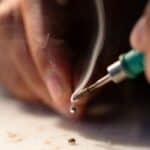Having an asymmetrical face can affect how you feel about yourself. Diverse factors like genetics, lifestyle, and injuries can contribute to this condition. There are several methods to help correct facial asymmetry, from natural facial exercises to cosmetic procedures.
For those looking for simple changes, adjusting sleep positions can be beneficial. Sleeping on your back instead of your side can help. Adding facial exercises to your routine can also make a difference over time. These exercises target the muscles and can promote better facial balance.
More advanced treatments include fillers, implants, and rhinoplasty. These options aim to adjust and harmonize facial features. Consulting a qualified professional can guide you in choosing the right approach for your needs.
Understanding Facial Asymmetry
Facial asymmetry can be caused by many factors, including genetics and lifestyle habits. To better understand this, we’ll look into common causes and how to assess your own facial balance.
Common Causes of Asymmetry
Genetics
- Many people are born with slight differences in their facial structure. This is often due to genetics and is normal.
Developmental factors
- As someone grows, issues like a cleft lip or palate can affect the symmetry of their face. These conditions usually need medical treatment.
Lifestyle habits
- Chewing on one side of the mouth more than the other can lead to an uneven face. Poor posture, like leaning on one side while sitting, can also cause asymmetry.
Aging
- As people age, their faces lose volume and muscle tone. This can make one side of the face look different from the other.
Injuries and medical conditions
- Conditions like Bell’s palsy, a stroke, or trauma to the face can cause sudden asymmetry. Injuries to the jaw or severe sun damage can also affect facial symmetry.
Assessing Your Facial Balance
Use a mirror
- Look straight into a mirror and take note of any differences between the two sides of your face. Check features like your eyes, nose, lips, and jawline.
Take measurements
- Measure the distance from the middle of your pupils to the corners of your mouth. See if both sides are equal.
Check facial lines and shape
- Draw or imagine vertical lines down from your forehead to your chin. Look for any obvious differences.
Look at your photos
- Use recent photos to spot changes or imbalances in facial proportions.
Observe facial expressions
- Pay attention to your daily habits and facial expressions. Notice if you often use one side of your face more than the other.
Consult a professional
- If you see significant asymmetry, it’s a good idea to consult a doctor or orthodontist. They can provide ways to improve facial balance, such as exercises or medical treatments.
Understanding these aspects can help you notice and address any facial asymmetry.
Corrective Techniques and Treatments
There are several ways to address an asymmetrical face. These include non-surgical methods like facial exercises and professional cosmetic procedures like surgeries and injections.
Non-Surgical Improvement Methods
Facial Exercises:
Facial exercises can improve symmetry. Simple activities like cheek lifts and puffing out the cheeks can help tone facial muscles. These need to be done regularly for best results.
Posture:
Maintaining good posture can ensure balanced muscle use on both sides of your face. Adjust how you sit, stand, and sleep for better positioning.
Makeup:
Makeup is a quick fix to make a face look more symmetrical. Using foundation, concealer, and highlighting can balance uneven areas. Skilled makeup artists can provide tips on proper techniques.
Lifestyle Choices:
Life habits can impact facial symmetry. Reducing stress, not smoking, and staying hydrated can keep skin healthy. Proper blood flow and skin health are important.
Professional Cosmetic Procedures
Dermal Fillers and Botox:
Fillers like hyaluronic acid and Botox injections can create symmetry. These procedures are precise and non-invasive. They can fill in uneven spaces and smooth out lines.
Surgical Options:
For significant asymmetry, surgery may be necessary. Rhinoplasty adjusts the nose while blepharoplasty corrects eyelids. Facelifts can tighten skin overall. These require recovery but have lasting results.
Clinical Research and Studies:
There is ongoing research into facial symmetry. Such studies ensure techniques are effective and safe. Professional advice and up-to-date information are key before proceeding.
Frequently Asked Questions
There are various ways to address facial asymmetry ranging from natural methods to surgical options. Here are answers to the most common questions on this topic.
What natural methods can improve facial symmetry?
Natural methods like facial exercises, good posture, and a balanced diet can help. Face massages can also improve muscle tone and symmetry.
Can sleeping positions affect facial asymmetry, and how can it be corrected?
Yes, sleeping on one side can cause facial asymmetry. To correct this, try changing your sleeping position and use a supportive pillow that keeps your head aligned with your spine.
Are there non-surgical options to correct an asymmetrical face?
Yes, non-surgical options include injectables and fillers. These can help balance facial features. Regular treatments are often needed to maintain the results.
What exercises can help address facial asymmetry?
Exercises like cheek puffing and exaggerated expressions can tone facial muscles. For example, puff out your cheeks, move the air from one side to the other, and repeat several times a day.
Is it possible to correct facial asymmetry caused by sleeping on one side?
Yes, changing your sleeping habits can help. Use a different pillow and sleep on your back or alternate sides to reduce the impact.
Do dental braces help in correcting facial asymmetry?
Yes, dental braces can help if the asymmetry is due to jaw alignment. They can correct the bite and improve facial balance over time. Make sure to consult with a dentist or orthodontist for the best results.







